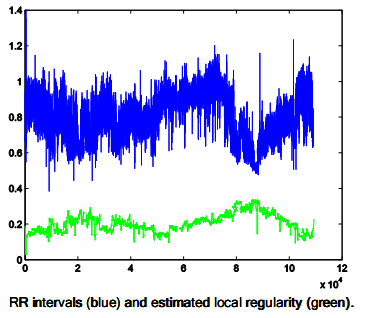ECG analysis and modeling
This study is conducted in the frame of the DIGITEO DIM “ANIFRAC” project, which involves INRIA, ECP and Supelec. It is performed partly in collaboration with Pr. Chevalier at Inserm Lyon and Pr. Locati in Milano.
ECG and signals derived from them are an important source of information in the detection of various pathologies, including e.g. congestive heart failure, arrhythmia and sleep apnea. The fact that the irregularity of ECG bears some information on the condition of the heart is well documented (see e.g. PhysioNet). Regularity parameters that have been studied so far in the literature include mainly the box and regularization dimensions (see this paper at http:), the local Hölder exponent and the multifractal spectrum. These have been found to correlate well with certain pathologies in some situations.
We participate in this research area in two ways:
- we use refined regularity characterizations, such as the regularization dimension, 2-microlocal analysis and advanced multifractal spectra for a more precise analysis of ECG data. This requires in particular to test current estimation procedures and to develop new ones,
- we build stochastic processes that mimic in a faithful way some features of the dynamics of ECG. Preliminary studies we have conducted have shown that the local regularity of RR intervals, estimated in a parametric way based on a modelling by an mBm, displays correlations with the amplitude of the signal, a feature that seems to have remained unobserved so far [ref]. See figure below. In other words, RR intervals behave as SRP. We believe that modelling in a simplified way some aspects of the interplay between the sympathetic and parasympathetic systems might lead to an SRP, and explain both this self-regulating property and the reasons behind the observed multifractality of records. This will open the way to understanding how these properties evolve under abnormal behaviour.
We concentrate on the specific pathology of arrhythmia, in view of classification and detection.
The ultimate goal is to obtain an algorithm for the prediction of various types of cardiac arrhythmias based on the idea that, if ECG are well modelled by self-regulating processes, it seems plausible that arrhythmias will modify the dynamics of the relation between the amplitude of the signal and its local regularity. Such changes should be noticeable on estimations of the g function of the self-regulating process, providing reliable detection.



